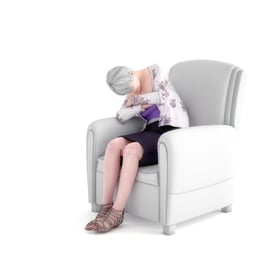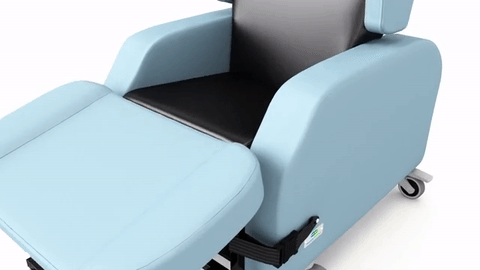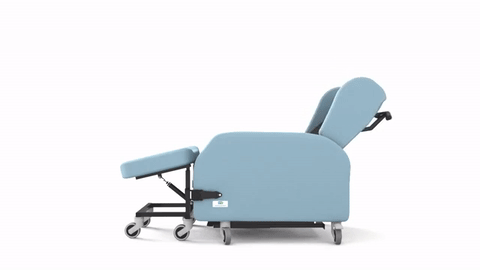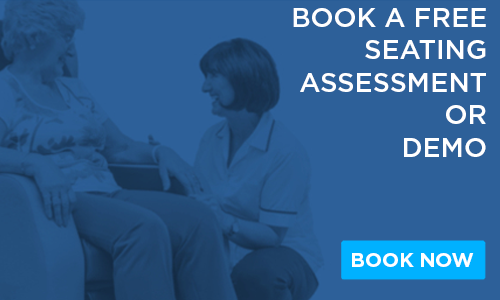Back Cushions Are Not Used When a Person Is Restrained in a Chair Because
Every so often a very sad story appears on the news about cases of abuse of elderly patients in care homes, having being restrained in their chairs. In different countries and in different regions, the regulations and rules around restraint differ. Sometimes even within one facility, the guidelines can differ from unit to unit depending on the patient groups. In this article, I'm aiming to outline some of the issues around restraint and ways that proper seating can help reduce some of the risks around this contentious issue. Please bear in mind that you must follow the guidelines set out in your own place of work and comply with your internal, regional or national laws and regulations around restraint. CLICK HERE TO BOOK A DEMONSTRATION OF THE ATLANTA CHAIR In 2016, we read about a case in Northern Ireland where an elderly gentleman with dementia was tied to his chair by two care home employees and left unattended for at least two hours. This was a horrific ordeal for the gentleman and a tragic situation for his family to learn, who were absolutely devastated when they discovered what happened, days after the incident had occurred. On examination they found bruises and marks on his arms. This obviously caused the gentleman great pain and distress, and the incident affected his personality afterwards, leaving him nervous and withdrawn. The care home in question has since closed and the member of staff found guilty of assault. Unfortunately this is not an isolated case. Often with late stage dementia patients and patients with other neurological conditions; they can pose a safety risk to themselves and to others. They might impulsively try to stand up whilst forgetting that they cannot weight bear, therefore they are a high falls risk. Another key concern is when patients might become agitated and lash out, as they risk injuring themselves or others. As a result of this, we see restraint being used more often, and most commonly, the use of belts/lap belts as a safety measure. When a patient is individually assessed and matched with a chair to meet their needs, often the need for restraint is reduced and incidence of falls from chairs can be lower. Seating Matters provide complimentary, no obligation Seating Assessments with our clinician's at a time and place that suits you and your patient. CLICK HERE TO ARRANGE A SEATING ASSESSMENT Your elderly mother has dementia. She now lives in a care home specially catering for neurological conditions. She uses a wheelchair for mobility. On occasion she has been known to stand up and stumble from her wheelchair. She needs help completing this task but sometimes she forgets that she is not strong enough to stand up on her own. Just a few days ago she unfortunately had a nasty fall, which resulted in an open head wound and a trip to the Emergency Department. You were devastated when you saw the after effects of this fall and vowed you would do whatever possible to ensure it doesn't happen again. You talk to the staff at the care home about the various options to prevent this and keep her safe, which include restraint. Weigh up the pros and cons of the situation: Restraint is a complex subject. At Seating Matters we know that when patients are matched with seating appropriate to their size and clinical needs, the need for restraint is often reduced . We have seen the difference a proper chair can make to a patients' quality of life, comfort and safety. If a patient is sitting in an over-sized standard chair which is not tailored to their requirements, they are more at risk of falling out and causing injury or harm. When they are safe, supported and snug within their chair which is designed for falls prevention and is exactly matched to their needs, they can be less agitated, more likely to sit peacefully and be safe, enjoying their surroundings. This can allow the patient a greater sense of independence and dignity, rather than being restrained which can have psychological as well as physical side effects. The real danger with restraining a patient is where the use of restraint is abused to the extent where it is used as a result of convenience rather than necessity. Sometimes we hear of extreme examples where shocking and unacceptable levels of restraint are applied to the most vulnerable members of our society. Although it can be abused in some extreme cases, most often it is used by a care giver as a last resort when they wish to protect the patient from doing physical harm to themselves or other patients. Sometimes the care giver may know of no other way to prevent such harm, and therefore they see a temporary restraint as the least harmful option. While definitions may vary from region to region, generally, that which restricts free movement of the patient can be considered restraint. In terms of specialist seating, the following things can be considered as restraint: In my experience, I have witnessed many cases where belts have been unnecessarily prescribed. There could be significantly less requirement for belts if patients were seated properly in a chair suited to their physical dimensions which keeps them feeling safe and secure. By belting them into a chair, they are restricted to remain in their chair and their independence and function are adversely affected. We only recommend belts are used during transportation or after a thorough risk assessment. Lap Trays are very useful to enable self feeding from the comfort of the patients chair, however if not removed once lunch or dinner time is over, these can be considered a restraint as they impede the free movement of the patient in the chair. Tilt in space can be a useful function in order to easily redistribute pressure and to improve positioning and comfort. If abused and a patient is left in tilt for long periods of time without the ability to remove themselves from tilt, it could be considered counterproductive and therefore a restraint. The use of tilt should be prescribed in appropriate circumstances and closely monitored and managed. Often a 5 minute tilted position is sufficient in order to redistribute pressure and re-oxygenate tissues to reduce the risk of developing pressure injuries, after which the patient can be tilted back to a normal upright sitting position. There is no easy or quick answer to the question of using restraint. It should always be risk assessed on an individual case by case basis. The rules around restraint are very complex and are different in each geographical area we encounter. What needs to be reduced is the use of unnecessary restraint where it is being used out of convenience rather than necessity. Excessive use of restraint leads to risks of negative physical and emotional side effects for the patient. In all situations the least-risk option should be considered, i.e. consider the use of tilt in space to reduce agitation in the chair, versus not using tilt in space and the client becomes agitated and steps out of the chair, risking a serious injury from a fall. When restraint is approved for use it must be closely monitored to determine the effect it has on the patient both physically and psychologically. If the use of restraint is being considered to keep a patient or loved one safe, consider why and seek to fix the root of the problem, not just address the symptom which is a short term fix. Restraint is not the only answer. Ask yourself these key questions about their current situation: Can they sit up straight independently or is their body falling to the side, or sliding forward? They might require some additional postural support to maintain a mid-line postural position. If their posture is affected by muscle weakness, a spinal condition like scoliosis, or gravity, they are likely to be uncomfortable and at risk of falls and sliding out of the chair. The Atlanta™ from Seating Matters has been called a 'Magic Chair' in the past by clinicians. With its deep reclined seat and back angle recline, it creates a very safe and comfortable position for patients. It comes with an adjustable angle leg rest for optimum comfort. In some cases, patients with conditions such as Huntington's disease have experienced a reduction in involuntary movements in the past and numerous patients with dementia have shown a reduction in agitation when using this chair properly. It is a fantastic chair to consider for any patient who presents as a falls risk. If there is anything we can assist you with, we encourage you call us at any times with your questions or queries and we'd be happy to help and provide our advice. We have trained Seating Specialists at the end of the phone, on email or live chat ready to help. *Note - the purpose of this blog is to give an overview of the product with some tips to consider on its use. This is not intended to be a substitute for professional or medical advice, diagnosis, prescription or treatment and does not constitute medical or other professional advice. For advice with your personal health or that of someone in your care, consult your doctor or appropriate medical professional.Restraint and the Law
Consider this Situation
The Issue of Restraint

The Dangers of Using Restraint
What is Considered Restraint?
Risk Assessment
5 Top Tips to Consider Appropriate Use of Restraint

Reduce Restraint and Prevent Falls with the AtlantaTM Chair

Ask us for Help
CLICK HERE TO ARRANGE A SEATING ASSESSMENT OR CHAIR DEMONSTRATION

Back Cushions Are Not Used When a Person Is Restrained in a Chair Because
Source: http://blog.seatingmatters.com/using-restraint-in-care-homes
Post a Comment for "Back Cushions Are Not Used When a Person Is Restrained in a Chair Because"